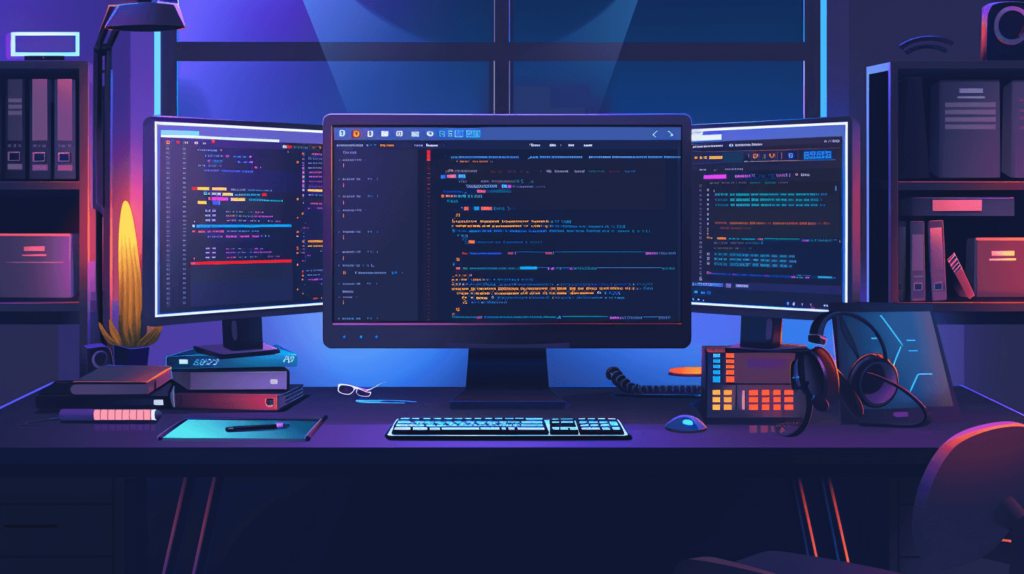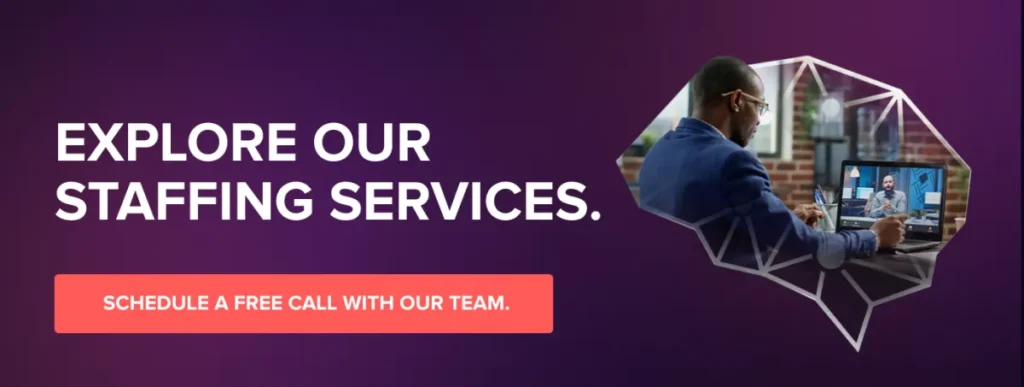Introduction

Welcome to the dynamic, ever-evolving world of front-end development—a realm where creativity meets functionality, transforming the vast digital landscape into a user-friendly, visually captivating experience. Today, websites and applications stand as the face of nearly every business and personal endeavor. They are the first point of interaction between a company and its customers, making the role of front-end developers not just important, but absolutely crucial.
If your goal is to craft an exemplary Front-End Developer job description that stands out in today’s competitive market, look no further. Click the link below for a complimentary download of our premier job description template. This document is not just a template—it embodies the core principles and best practices of C9Staff’s renowned hiring methodology. It’s designed to provide you with a robust foundation for creating a job description that not only attracts top-tier talent but also aligns perfectly with your organizational needs. Leverage our expertise to enhance your recruitment strategy and secure the ideal candidate for your team.
Front-End Developer Job Description Template

As you navigate through the complexities of the digital age, whether you are an employer, a tech leader, or an aspiring developer, understanding the nuances of this critical role is paramount. Front-end developers are the architects of the web; they build the outward-facing parts of websites that users interact with. Through their expertise, websites become more than just functional—they become engaging and aesthetically pleasing. They transform lines of code into the sleek, intuitive interfaces that define our digital experiences.
But why is a meticulous job description so pivotal? Crafting an accurate and detailed job description is the first step in capturing and nurturing this talent. It sets the expectations and aligns the visions of both the employer and the developer, ensuring that each new hire is not just a fit, but the right fit for the role. In this guide, you will discover how to articulate the essential skills, responsibilities, and the creative and technical prowess required for a front-end developer.
This article will serve as your comprehensive guide, whether you are crafting or seeking to understand job descriptions for front-end developers. Prepare to dive deep into what makes a job description not just good, but great, as we explore together how to outline the skills, qualifications, and innovative mindset needed to excel in this vibrant field. Join me as we unravel the threads that weave the vibrant tapestry of front-end development, setting the stage for success in the digital world.
Front-End Mastery: The Ultimate 2024 Developer Roadmap to Success
Understanding the Role of a Front-End Developer

Today you’ll step into the dynamic world of front-end development—an area as creative as it is technical, shaping the very face of the internet we interact with. Whether you’re a seasoned tech leader or a novice eager to delve into the tech industry, this session is designed to demystify the role of a front-end developer and clarify its indispensable value.
What is Front-End Development?
Front-end development refers to the process of creating the graphical user interface of a website or web application through the use of HTML, CSS, and JavaScript, so that users can view and interact with that interface directly. Unlike back-end developers, who focus on servers, databases, and applications that work behind the scenes, front-end developers work on the client side, crafting the visible parts of the website—the layout, the design, the interactivity.
Why is it critical?
Imagine you’re visiting a website for the first time. What impacts you immediately is not how the data is processed on the server but how smoothly the page loads, how intuitively you can navigate, and how visually appealing the elements are. This is the art and science of front-end development. It’s pivotal because it creates the first impression, directly influencing user experience and engagement.
Core Responsibilities:
Coding: Front-end developers write the code that dictates how different parts of a website look to the viewer. They transform design concepts into reality using HTML for structure, CSS for styling, and JavaScript for functionality.
Debugging: They spend considerable time testing and fixing bugs to ensure the website runs smoothly across all browsers and devices. Every glitch you don’t see is a problem they’ve already solved.
Designing User Interfaces: Beyond mere functionality, they design interfaces that are intuitive and user-friendly. They need a keen eye for design and usability to make websites accessible and enjoyable for all.
Consider this scenario: A front-end developer is tasked with creating an e-commerce site. They must not only ensure that the product listings are organized and searchable but also that the checkout process is quick, the buttons are easily noticeable, and the site as a whole is aesthetically pleasing and secure. This mix of creativity and technical skill is what makes a front-end developer’s role so unique and essential.
The Blend of Creativity and Technical Skill:
As you can see, front-end development is not just about writing code. It’s about creating an experience. It demands a balance of creativity to design compelling layouts and the technical prowess to implement complex functionalities that make a website interactive and user-centric.
Essential Skills and Qualifications

Whether you are looking to hire the next tech wizard or aiming to become one, understanding these essential skills will significantly influence your approach and success in the vibrant world of front-end development.
Technical Skills
Let’s begin with the technical backbone of any front-end developer’s skill set. HTML (HyperText Markup Language), CSS (Cascading Style Sheets), and JavaScript are the three pillars that support all web development. HTML allows you to structure web content, laying the foundation for web pages. CSS steps in to style this content, managing everything from layout to colors and fonts, thereby dictating the look and feel of a website. JavaScript, on the other hand, brings these static elements to life, introducing interactivity and complex features that enhance user experience.
Frameworks such as React or Angular represent the next layer of essential technical skills. React, developed by Facebook, is renowned for its efficiency in updating and rendering the right components when your data changes. Angular, a Google product, is a comprehensive framework that’s well-suited for developing scalable and well-structured web applications. Mastery of these technologies allows you to build responsive, efficient, and effective web interfaces that stand out in today’s digital landscape.
For instance, imagine you are tasked with developing an interactive web application that allows users to visualize data changes in real-time. Using JavaScript along with a framework like React could enable you to efficiently manage state changes that reflect data updates without refreshing the page, providing a seamless user experience.
Soft Skills
While technical skills are imperative, the role of soft skills cannot be overstated. Problem-solving skills empower you to tackle unexpected challenges during development, from debugging issues that arise to adapting existing solutions to better meet user needs. Communication is crucial, not only for effectively discussing project requirements with clients but also for collaborating with team members. Being able to clearly articulate your ideas and also listen to others’ perspectives can greatly enhance the success of your projects.
Teamwork also plays a pivotal role. A front-end developer seldom works in isolation. Whether it’s aligning with back-end developers to ensure server-side functions are correctly integrated or working with designers to ensure the visual and interactive elements of a web application align, effective teamwork skills are a must.
Continuing Education and Certifications
In the fast-evolving tech landscape, continuous learning is key. Optional certifications in specific frameworks or technologies, like a certification in Angular or a specialized course in advanced CSS techniques, can make a developer more competent and competitive in the job market. These certifications not only update your skill set but also signal to potential employers or clients that you are committed to maintaining cutting-edge knowledge in your field.
Crafting an Effective Job Description

Today, we are focused on constructing job descriptions that don’t just attract candidates but secure the right front-end developer for your team. Let’s dive into creating a job description that stands out.
Components of an Effective Job Description
The cornerstone of any job description is the job title. It’s crucial that this title, whether it be ‘Junior Front-End Developer’ or ‘Senior Front-End Engineer’, clearly communicates the level and type of role. A precise title sets the tone and expectations right from the start, aligning the job listing with the candidates’ job search queries.
Duties and Responsibilities
When detailing the duties and responsibilities, ensure that they accurately reflect the daily activities and overarching goals of the role. It’s essential that these responsibilities resonate with the needs of your organization and the reality of the position. For example, if the role requires significant collaboration with UX designers and back-end teams, make this clear. This clarity helps potential candidates understand their day-to-day tasks and assess their own fit for the role.
Skills and Educational Requirements
Moving to skills and education, balance is key. Essential skills for a front-end developer include a solid grasp of HTML, CSS, and JavaScript. Additionally, familiarity with frameworks like React or Angular should be considered a strong plus. Educate the reader on differentiating between must-have skills and nice-to-have qualifications, which can widen your pool of applicants while still focusing on core competencies.
Work Environment and Team Culture
Describing your work environment and team culture is not just about attracting candidates—it’s about attracting the right ones. Be authentic and inviting in your description of the company’s ethos and the team’s dynamics. This transparency helps set realistic expectations and attracts candidates who are more likely to thrive in and contribute positively to your workplace.
Expected Outcomes and Career Progression
Highlighting expected outcomes and potential career progression within the job description can significantly enhance its appeal. Specify what achievements are expected in the first six months or a year. Show potential career paths within the company to attract candidates who are looking for growth and want to invest in a long-term relationship with your company.
As you craft this job description, remember that you’re not just listing requirements—you’re inviting someone into your professional family. Make sure that every word reflects the importance and value of the role, and the kind of person who will best fill it. By the end of this process, you should have a job description that not only captures the essence of the role and its requirements but also showcases why your company is a place where top talent can grow and succeed.
If your goal is to craft an exemplary Front-End Developer job description that stands out in today’s competitive market, look no further. Click the link below for a complimentary download of our premier job description template. This document is not just a template—it embodies the core principles and best practices of C9Staff’s renowned hiring methodology. It’s designed to provide you with a robust foundation for creating a job description that not only attracts top-tier talent but also aligns perfectly with your organizational needs. Leverage our expertise to enhance your recruitment strategy and secure the ideal candidate for your team.
Front-End Developer Job Description Template

What Candidates Look For in a Job Description

Let’s dive into what truly makes a job posting stand out to potential candidates. In today’s competitive tech landscape, understanding what job seekers value can transform your job description from ordinary to exceptional.
Work-Life Balance
First and foremost, work-life balance is a key factor that candidates weigh when considering job opportunities. Developers are looking for positions that offer flexible working hours, the possibility of remote work, and a supportive work environment that prioritizes mental and physical health. Highlighting these aspects in your job description not only attracts more candidates but also resonates with their desire for a balanced life. For instance, if your company offers four-day workweeks or the ability to work remotely, make these benefits clear in the job description.
Growth Opportunities
Growth opportunities are equally critical. Today’s job seekers, especially in technology, are not just looking for a job; they are looking for a place to grow their skills, advance their careers, and continuously learn. Detailing paths for advancement, ongoing training programs, and potential mentorship opportunities can significantly enhance the attractiveness of your job description. Make it clear that your company invests in the development of its employees, which not only attracts ambitious candidates but also those who are likely to stay and grow with your company.
Technology Stack
The technology stack that a company uses is another major consideration for front-end developers. Candidates tend to look for job descriptions that align with their own skills and areas of expertise, or with new technologies they wish to explore. Be transparent about the technologies your team uses; whether you’re working with cutting-edge frameworks like React or more established technologies, clarify this in the job description. This transparency helps candidates gauge if they’ll be a good technical fit and if they’ll enjoy the work they’re engaging with.
Remote Work Possibilities and Compensation Ranges
Transparency about remote work possibilities and compensation ranges plays a pivotal role in attracting top talent. A clear statement about whether a position is remote, hybrid, or onsite, as well as a competitive and transparent compensation range, sets clear expectations and demonstrates your company’s honesty and openness. This builds trust from the very first interaction and helps attract candidates who are comfortable with these aspects.
In crafting your job description, remember that you are not just listing a vacancy; you are inviting someone to join your professional community. By emphasizing these key elements—work-life balance, growth opportunities, the technology stack, and transparent employment terms—you cater to what front-end developers are actively seeking in their careers.
Understanding and addressing these candidate-focused elements can truly elevate your job descriptions, making them not just informative but truly appealing to the best talent in the market. Use these insights to ensure that your job descriptions do more than fill a vacancy—they attract the right talent who are eager to grow and contribute to your success.
Are you ready to supercharge your career and land your dream job? C9Staff is here to help you make that leap! Click the link below to submit your resume to our talent acquisition department. If your qualifications align with our client requirements, we’ll reach out to discuss potential opportunities tailored just for you. Don’t miss the chance to connect with leading employers and take your career to new heights. Submit your resume today, and let us help you find the perfect job match based on your skills and ambitions.

Trends in Front-End Development: Shaping the Future of Web Development

Welcome to this insightful exploration of the current and future trends in front-end development, a field that continues to evolve rapidly, pushing the boundaries of what’s possible in web development. As both seasoned and aspiring front-end developers, along with employers keen on understanding these changes, you’re in the perfect position to harness these trends to enhance your careers and organizations.
Emerging Tools and Technologies
Let’s start with the tools and technologies that are shaping the industry. Vue.js, for instance, is fast gaining traction among developers for its simplicity and ease of integration. This progressive JavaScript framework is designed to be incrementally adoptable, making it a perfect choice for projects requiring swift development cycles. Similarly, React’s Concurrent Mode offers advanced features that enable developers to improve user experience through smoother rendering and enhanced responsiveness, even in complex applications. These tools not only improve development efficiency but also significantly enhance product outcomes, making proficiency in them highly desirable for candidates and crucial for employers to seek out.
The Imperative of Mobile-First and Responsive Design
Moving on to design philosophies, the mobile-first approach is becoming increasingly important. In today’s world, where mobile internet usage often surpasses desktop usage, developing with a mobile-first mindset is not just a trend but a fundamental shift. This approach involves designing an online experience for mobile before designing it for desktop or any other device, thereby ensuring that all users have a seamless experience regardless of device size or type.
The technical challenges associated with mobile-first and responsive design are significant, involving a deep understanding of flexible layouts, touch interfaces, and various device capabilities. The creative solutions, however, from responsive images to fluid grids, allow for websites that are not only functional but also aesthetically pleasing across devices.
Engaging Directly with Trends
As you engage with these trends, think about how they can provide you with a competitive edge. For employers, understanding and integrating these technologies into your job descriptions can help attract top-tier talent who are eager to work with cutting-edge tools and methodologies. For developers, showcasing expertise in these areas can make you a standout candidate, one who is well-prepared to meet the challenges of modern web development.
Are you looking to source, recruit, hire, train, manage, and deploy the ideal Front-End Developer for your organization? C9Staff invites you to schedule a free exploratory call with one of our account managers today. During this call, we’ll carefully listen to your specific needs and provide recommendations for top candidates at competitive prices—completely free of charge. This is your opportunity to discover how our tailored services can help you secure the best talent suited to your unique requirements. Contact us to schedule your free exploratory call now and start finding the perfect fit for your team.

Conclusion

As we conclude this comprehensive workshop on crafting exceptional front-end developer job descriptions, it’s essential to reflect on the critical insights shared today. Whether you are an HR professional, a hiring manager, or a job seeker, the information presented is designed to significantly enhance your recruitment strategies or align your career path with market demands.
We’ve explored the essential skills and qualifications that front-end developers must possess, which include not only technical proficiencies in HTML, CSS, and JavaScript but also soft skills like problem-solving and teamwork. Effective job descriptions clearly detail these requirements, providing a clear roadmap for both employers and candidates. Moreover, we discussed the emerging trends such as mobile-first design and the use of modern frameworks like React and Vue.js, which are shaping the field and should be considered in both hiring strategies and career development plans.
For hiring managers and HR professionals: I encourage you to refine your job descriptions with the insights provided. Focus on clarity in job roles, transparency about your company culture, and specificity in the skills and technologies required. These elements are not just bullet points; they are your first interaction with potential candidates. Make them count by being as clear and detailed as possible.
For job seekers: Align your skills and resumes with the key elements that employers are seeking. This alignment goes beyond listing skills—it involves demonstrating how you’ve applied them effectively in past roles. Also, embrace continuous learning and adaptation to keep pace with the fast-evolving tech landscape. Enroll in courses, obtain certifications in emerging technologies, and stay informed about industry trends.
You now have the tools and knowledge to make impactful changes, whether in drafting a job description that attracts the right talent or tailoring your resume to meet the demands of today’s job market. Implementing these strategies can significantly enhance the effectiveness of your hiring practices or the competitiveness of your job applications, setting you apart in the robust field of front-end development.
Let’s move forward from today’s session with a commitment to apply these insights and strategies, ensuring that we not only keep pace with but lead in the ever-evolving world of technology. Together, we can shape a future where the right talents find the right opportunities, creating a perfect match that drives personal careers and organizational success forward.




